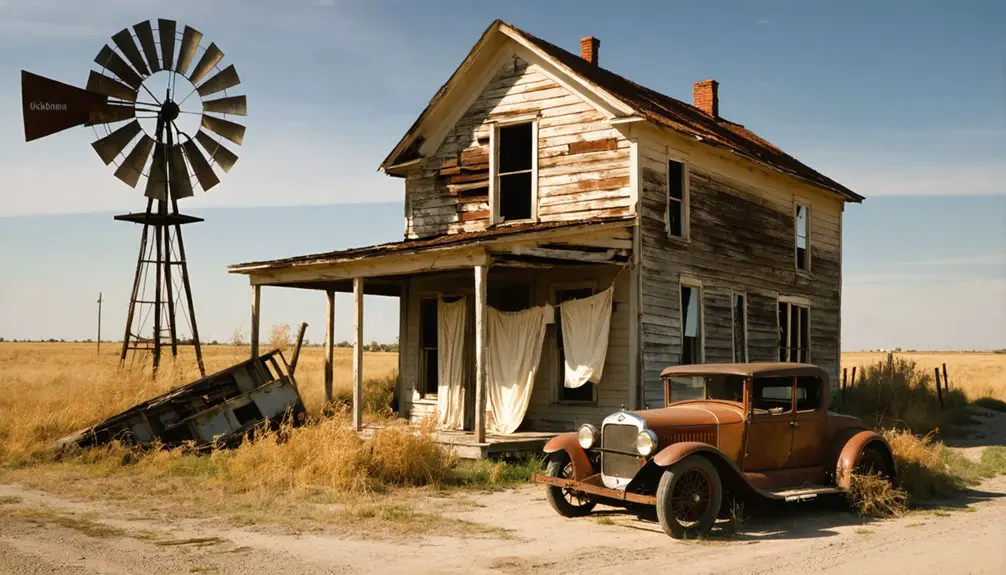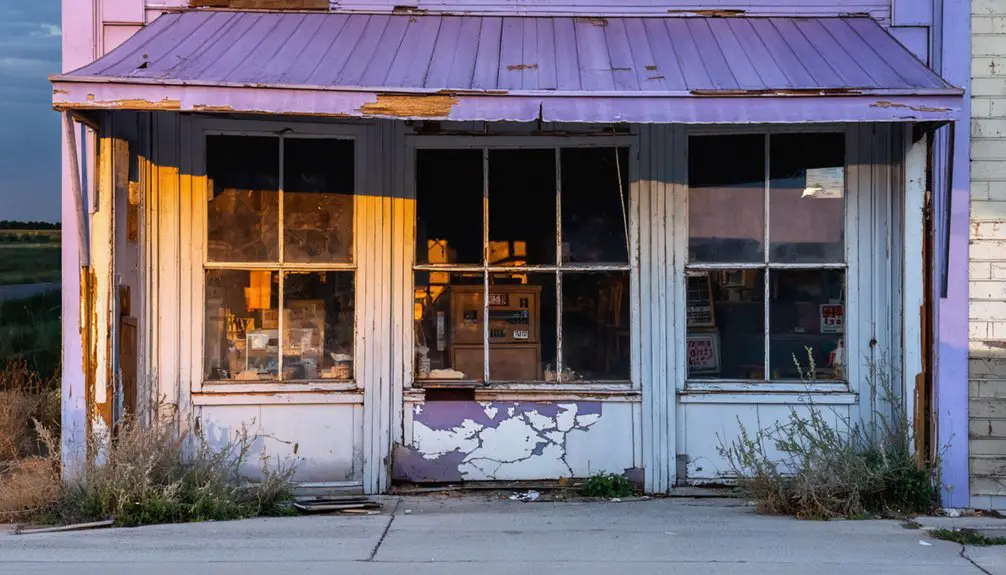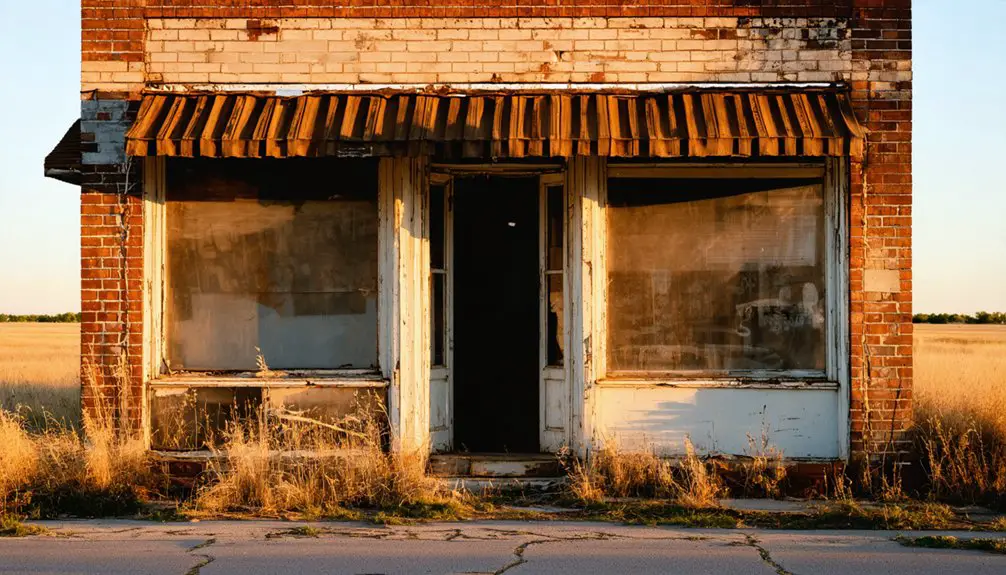You’ll find Violet Springs, Oklahoma among the ghost towns of Pottawatomie County, where it emerged as a frontier settlement in 1891. The town flourished through cattle ranching, cotton farming, and a strategic whiskey trade near Indian Territory. Its distinctive purple-tinted springs and limestone outcroppings attracted settlers, but the combined forces of prohibition in 1907 and the Great Depression led to its decline. The site’s haunting remnants, including the “human wolves” grave, hold untold stories of frontier life.
Key Takeaways
- Violet Springs was founded in 1891 as a frontier cattle town in Oklahoma Territory, known for its purple-tinted mineral springs.
- The town flourished initially through whiskey trade and agriculture but declined after Oklahoma statehood brought prohibition in 1907.
- Severe agricultural collapse and drought in the 1930s led to mass exodus, with 60% of farmers abandoning their lands.
- Only three occasionally occupied structures remain today, along with the historic Violet Springs Cemetery and Sacred Heart Mission ruins.
- The town’s legacy is preserved through historical documentation, local archives, and the Sacred Heart Mission’s listing on National Historic Register.
The Origins of a Forgotten Settlement
While many ghost towns emerged from mining or railroad ventures, Violet Springs began in 1891 as a cattle rancher’s vision when Perry established this settlement in what would become Pottawatomie County, Oklahoma Territory.
The pioneer economy quickly took shape when A.J. “Andy” Morrison launched a key business shortly after the town’s founding, setting the stage for rapid growth.
A single entrepreneur’s bold venture ignited Violet Springs’ economic engine, transforming a fledgling settlement into a booming frontier town.
By the mid-1890s, you’d have found a bustling commercial hub centered on a thriving whiskey trade. The town’s strategic location near Indian Territory, where alcohol was prohibited, created a perfect economic opportunity. Like many whiskey towns, Violet Springs thrived until Oklahoma achieved statehood in 1907.
Within just a few years, Violet Springs boasted five stores and eight saloons, establishing itself as one of southeastern Pottawatomie County’s prominent liquor towns. Much like the town of Corner with its saloon, Violet Springs attracted a steady stream of customers seeking alcohol near the Indian Territory border.
Life in Early Violet Springs
You’d find daily life in early Violet Springs centered around agricultural labor, with settlers rising at “rosy-fingered dawn” to tend cotton fields, manage livestock, and maintain essential crops for survival.
The town’s social fabric came together primarily in its saloons and general stores, where residents could purchase supplies, exchange news, and find brief respite from their demanding routines. Like in Indiana’s early African American communities, residents established local meeting houses to strengthen their social bonds and preserve cultural traditions.
Your community gatherings would’ve likely occurred in makeshift social halls or churches, though specific details about Violet Springs’ meeting places remain limited compared to similar frontier settlements.
Daily Pioneer Routines
Life in early Violet Springs revolved around a harsh daily routine shaped by frontier challenges and limited resources. You’d find your pioneer chores centered around basic survival, with daily meals depending heavily on corn and whatever game you could hunt near the Little River.
Similar to Tecumseh’s early days, the town saw lumber yards and sawmills spring up to provide essential building materials.
Your typical day would include:
- Fetching water from local springs for drinking and household needs
- Tending to basic wooden shelters that offered minimal protection from the elements
- Hunting or gathering food from the game-rich areas near water sources
- Maintaining vigilance against potential threats, given the town’s reputation for violence
You’d need to stay alert while carrying out these tasks, as the proximity to Indian Territory and the prevalence of outlaws meant danger could strike at any moment. Basic farming equipment like six-inch turning plows was used to cultivate the land for sustenance.
The lack of modern conveniences like telegraphs or railroads made self-reliance essential.
Community Gathering Places
Several vibrant gathering spots defined the social fabric of early Violet Springs, with five stores and eight saloons serving as the town’s primary meeting places between 1895 and 1905.
Like many Oklahoma liquor towns, Violet Springs primarily served alcohol to residents from neighboring dry territories. The saloons, reflecting Violet Springs’ identity as a whiskey town, fostered lively social dynamics until Oklahoma’s 1907 statehood brought prohibition.
You’d find community interactions centered around these establishments, where locals and travelers exchanged news, goods, and stories. Today, visitors are reminded to obtain proper permissions before exploring these historic sites.
The local post office and general stores doubled as informal meeting spots, while the nearby Sacred Heart Mission provided an alternative gathering space focused on education and religious activities.
Even the town’s cemetery played a role in community life, with its haunting folklore and the infamous “murdered by human wolves” grave becoming part of local storytelling traditions.
Natural Features and Local Legends
You’ll find the namesake spring’s waters tinted with a distinct purple hue, created by unique mineral deposits and geological formations characteristic of central Oklahoma’s terrain.
The spring emerges from layered limestone outcroppings that have shaped the local watershed, influencing both the water’s coloration and its mineral content.
Native plants like wild violet clusters and prairie sage thrive around the spring’s edge, creating a microhabitat that historically attracted both wildlife and human settlers to this natural water source. The area’s natural beauty attracted early settlers who established Pleasant Valley nearby, drawn to the region’s scenic grazing lands.
Springs’ Purple-Tinted Waters
The mesmerizing purple waters of Violet Springs stand as one of Oklahoma’s most unusual natural phenomena. The distinctive purple pigmentation emerges from a complex interaction between mineral composition, local geology, and microbial life, setting it apart from typical clear or blue springs in the region.
You’ll find the spring’s unique coloration results from:
- Groundwater flowing through mineral-rich geological layers
- Natural chemical reactions triggered by water aeration and oxygen exposure
- Interactions between minerals and local microorganisms
- Influence of surrounding vegetation and organic matter
Native American tribes considered these waters sacred, attributing healing powers to their unusual hue. Unlike the crystal blue water commonly found in Spring Creek, these purple-tinted waters create a stark visual contrast in Oklahoma’s landscape.
The spring’s consistent flow maintains its mysterious purple tint year-round, while seasonal changes only affect the color’s intensity, preserving its status as a remarkable natural wonder that continues to captivate visitors.
Local Geological Formations
Nestled within Oklahoma’s diverse geological landscape, Violet Springs rests upon three distinct Mississippian-era formations that shape its unique terrain.
You’ll find the prominent Pitkin Limestone, characterized by its oolitic and bioclastic composition, stretching from eastern Oklahoma into the Arkansas Ozarks. Below this, you’ll encounter the Moorefield formation with its Tahlequah member, featuring massive gray limestone and distinctive cross-bedding patterns.
The area’s sedimentary layers include the Cloud Chief Formation‘s reddish-brown shales and gypsum deposits, which greatly influence local soil composition and terrain stability.
These geological formations create complex erosion patterns and affect groundwater movement through the region. The presence of fossils, including the marker species *Archimedes* bryozoan, helps geologists date and identify these ancient rock layers that tell the story of Oklahoma’s prehistoric past.
Native Plant Species
Alongside the distinctive geological formations, Violet Springs’ native flora paints a vibrant ecological portrait of Oklahoma’s natural heritage. The area’s native ecosystems showcase remarkable plant adaptations to the region’s variable climate.
You’ll find diverse vegetation zones characterized by:
- Prairie grasses like Little Bluestem and Switchgrass, which provide essential soil stabilization and wildlife habitat.
- Woodland species including Black Walnut and Serviceberry, offering food sources for local fauna.
- Native wildflowers such as Wild Bergamot and Indian Blanket, supporting vital pollinator populations.
- Indigenous fruit-bearing plants like Chickasaw and American Plum, which historically sustained both wildlife and human inhabitants.
The Southern Woolly Violet, particularly well-adapted to the sandy soils near Violet Springs, represents one of the area’s most distinctive native species.
The Great Depression’s Impact

During one of America’s darkest economic periods, Violet Springs fell victim to a devastating combination of agricultural decline and widespread drought that began ravaging Oklahoma in 1930.
You’ll find that this town’s struggles were intensified by its pre-existing economic weakness – having lost its liquor-based commerce after Oklahoma’s statehood in 1907, it couldn’t withstand the crushing pressure of the Great Depression.
The economic hardship hit local farmers particularly hard, with farm income plummeting 64% during the 1930s.
Population displacement became inevitable as tenant farmers, who made up over 60% of Oklahoma’s agricultural workforce, abandoned their lands.
Like many small Oklahoma communities, Violet Springs couldn’t recover from this perfect storm of prohibition enforcement, agricultural collapse, and mass exodus of residents seeking opportunities elsewhere.
Remnants of a Lost Community
As time has slowly erased most traces of Violet Springs‘ once-bustling community, only sparse physical remnants survive to tell its story.
Today, you’ll find these enduring pieces of cultural heritage scattered across the landscape:
- A handful of brick buildings, with three occasionally occupied structures standing as silent witnesses to the town’s past.
- The haunting Violet Springs Cemetery, featuring the infamous “human wolves” grave that’s become central to community memories.
- Nearby Sacred Heart Mission ruins, now listed on the National Register of Historic Places.
- Post office remnants and store foundations marking where commerce once thrived.
The surrounding roadways and landscape features still outline where this vibrant whiskey town once stood, though most buildings have vanished into history’s shadows.
Preserving the Town’s Legacy

While most physical traces of Violet Springs have faded into history, dedicated preservation efforts keep the town’s legacy alive through various channels.
Historical documentation by scholars like Jim W. Morris and Jim Marion Etter guarantees the town’s unique story as a thriving liquor town survives through written records and oral histories.
You’ll find community engagement primarily centered around the Violet Springs Cemetery, which features the famous “murdered by human wolves” grave that draws history enthusiasts and paranormal investigators alike.
Local historical societies maintain archives and research materials, while nearby Sacred Heart Mission, listed on the National Register of Historic Places, provides broader regional context.
Though limited funding and private land ownership present challenges, these preservation initiatives help guarantee Violet Springs’ remarkable past won’t be forgotten.
Frequently Asked Questions
Are There Any Documented Paranormal Activities Reported in Violet Springs?
You’ll find reports of ghost sightings at Violet Springs Cemetery, including phantom growls near a specific grave. While haunted locations are frequently discussed, there’s no official documentation confirming paranormal activity.
What Happened to the Original Town Records and Municipal Documents?
You won’t find most original documents – they’re missing archives, lost to time through neglect, fires, and weather damage. Without historical preservation efforts after the town’s decline, municipal records disappeared or deteriorated completely.
Can Visitors Legally Explore the Remaining Structures on the Townsite?
While you might be tempted to explore freely, you can’t legally enter remaining structures without proper visitor permissions. Current exploration regulations require landowner approval due to trespassing laws and safety concerns.
Were Any Notable Outlaws or Historical Figures Associated With Violet Springs?
You won’t find any documented outlaws tied directly to Violet Springs, despite its historical significance as a whiskey town. Local outlaw legends exist, but they’re connected to nearby towns like Corner instead.
Do Any Direct Descendants of Original Violet Springs Settlers Still Live Nearby?
You’ll find limited verifiable descendant stories due to scarce genealogical records. While some families may claim local heritage connections, there’s no conclusive evidence of direct settler descendants living near today.
References
- https://www.okhistory.org/publications/enc/entry?entry=GH002
- http://genealogytrails.com/oka/pottawatomie/countyhistory.html
- https://sites.rootsweb.com/~okpcgc/towns/violet.html
- http://sites.rootsweb.com/~oktttp/ghost_towns/ghost_towns.htm
- https://en.wikipedia.org/wiki/Pink
- https://indianahistory.org/research/research-materials/early-black-settlements/early-black-settlements-by-county/
- https://www.okhistory.org/publications/enc/entry?entry=SA002
- https://www.scribd.com/document/90368321/Pottawatomi-County-Oklahoma-History
- https://nationalcowboymuseum.org/explore/rushes-statehood-oklahoma-land-runs/
- https://okgenweb.net/pioneer/ohs/wood-jl.htm



